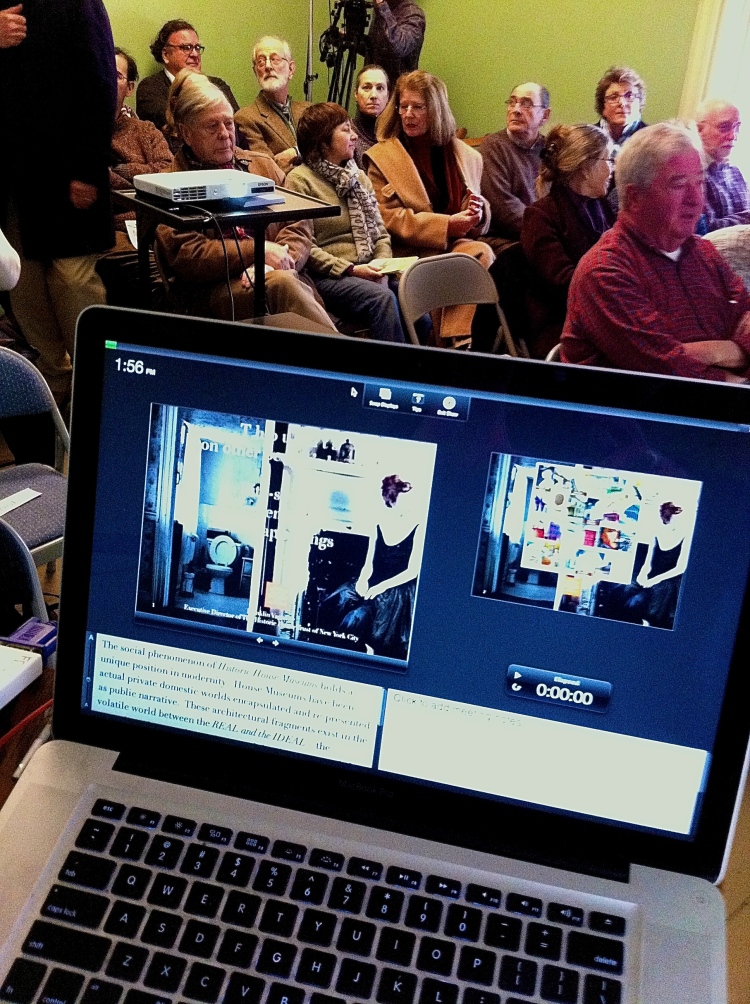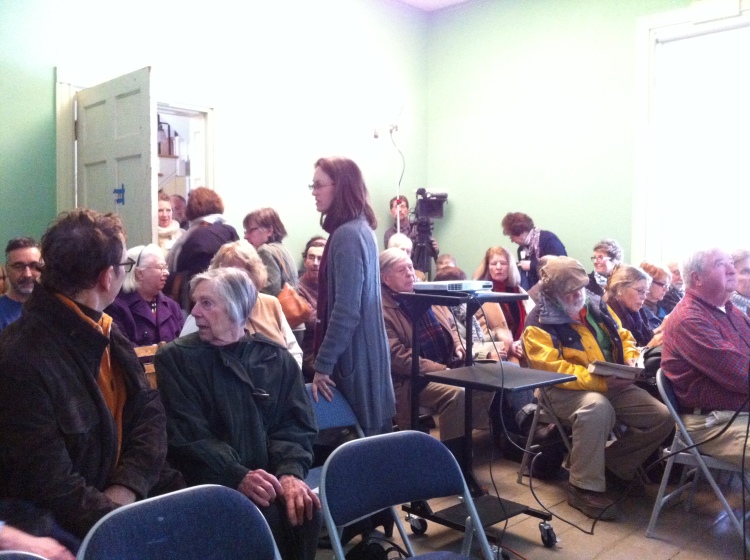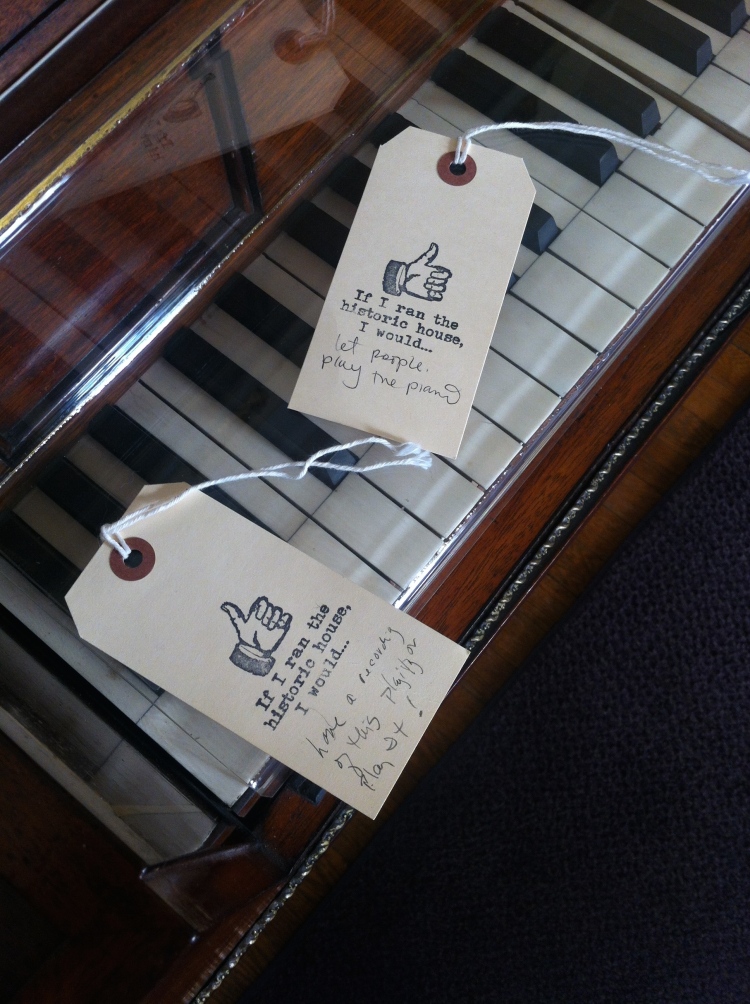 Moments before my lecture began, I snapped a picture of the crowd at the Thomas Cole Historic Site.
Moments before my lecture began, I snapped a picture of the crowd at the Thomas Cole Historic Site.
This past weekend I was asked to give two public lectures in upstate New York. One was at Clermont Historic House in Germantown, NY and the other at the Thomas Cole Historic site in the nearby town of Catskill. The Clermont presentation consisted of a discussion of our “Anarchist Guide to Historic House Museum” concepts followed by a hands-on workshop in the historic house itself. The Thomas Cole presentation was to concentrate solely on “Contemporary Art Happenings in Historic House Museums”. I was flattered to be asked to hold these two public forums and my hosts were perfect: They made me feel appreciated and valued. I hope the ideas we discussed will become useful for them. My thought this morning concentrates on the second presentation at the Thomas Cole Historic Site. I think everyone had early-winter cabin fever so it was standing room only, but this made for a nice intimate community to discuss innovative ideas in house museums. The video of the talk itself can be found HERE. The slides of the powerpoint can be found here Contemporary Art Happenings in Historic House Museums. F. Vagnone  The audience was a wonderful, receptive, and friendly group. The Thomas Cole House knows how to treat a guest! Thank you to their Board of Directors, Executive Director and Staff. Following the talk, I took questions and one comment stood out among the others. A quiet woman, whom I think was new to the crowd, raised her hand, I called on her, and she began to speak. Among other things, she told me to, “take what I am about to say personally”. I responded with a smile and she proceeded to voice her comment. “You are an idiot“. She went on to voice her concern that the ideas I presented were nothing less than the complete destruction of all that is valuable. She voiced her concerns in a very clear, non-anxious tone. She sincerely meant what she said and had no reservations about stating it. I smiled, not in a patronizing way, but from an honest appreciation of her thoughts. Why did I not get defensive and push back with all of the statistical data that we have been compiling about historic house museums? Why didn’t I tell her that these contemporary art happenings could be one of the pieces to our historic house museum puzzle? The answer is this: The room was filled to capacity to hear some unknown guy talk about art history and historic house museums. They each felt passionately regarding these fragile sites and took time out of their lives to hear my ideas and comment on them.
The audience was a wonderful, receptive, and friendly group. The Thomas Cole House knows how to treat a guest! Thank you to their Board of Directors, Executive Director and Staff. Following the talk, I took questions and one comment stood out among the others. A quiet woman, whom I think was new to the crowd, raised her hand, I called on her, and she began to speak. Among other things, she told me to, “take what I am about to say personally”. I responded with a smile and she proceeded to voice her comment. “You are an idiot“. She went on to voice her concern that the ideas I presented were nothing less than the complete destruction of all that is valuable. She voiced her concerns in a very clear, non-anxious tone. She sincerely meant what she said and had no reservations about stating it. I smiled, not in a patronizing way, but from an honest appreciation of her thoughts. Why did I not get defensive and push back with all of the statistical data that we have been compiling about historic house museums? Why didn’t I tell her that these contemporary art happenings could be one of the pieces to our historic house museum puzzle? The answer is this: The room was filled to capacity to hear some unknown guy talk about art history and historic house museums. They each felt passionately regarding these fragile sites and took time out of their lives to hear my ideas and comment on them. 

On Saturday I facilitated a hands-on workshop at Clermont Historic House site in Germantown, New York. The group was engaged, interested and willing to try anything!
Is this not what is needed for historic house museums and sites? ideas – dialogue – testing- failure- and – a re-boot? I was happy that a woman called me an “idiot”. Her comment showed me that 1. people still cared about these almost-forgotten sites and 2. that my presentation provided a safe forum for discussion. It is only from strong voices like hers that we will mediate a successful vantage point to see our next steps. I have never seen our research with historic sites and house museums as adversarial, but rather as framing a discussion in a way that a woman can come to a public presentation and voice her thoughts. 
As part of the Clermont hands-on workshop, we used the “Anarchist tags” to crowd-source our thoughts on the visitor experience.
So far, I have been called “a menace” and “an idiot” openly in my public talks about historic house museums. Finally I am beginning to believe there are people out there who care about the future of these sites. So next time I present in public, show up, voice your concern and make me feel useful.
Frank is just what we need at historic sites today – a passionate advocate with the statistics to show what works. We loved having him at the Thomas Cole House. I believe the exact words from the dissenting woman in the audience was “I think you’re nuts.”
LikeLiked by 1 person
Franklin…I just showed your Thomas Cole talk to my Historic Site Interpretation Class and although they may have had issues with some of the examples you showed–the Grange House especially rankled–all overwhelmingly agreed that simply making this part of the dialog is exciting, useful and a breath of fresh air. Agree or disagree, I believe this is another “tool” that should be added to the interpretation “tool box.” Keep up the great work. Look forward to reading “The Anarchist’s Guide…” and hope to assign it in class next year.
LikeLike
Whether you’re an idiot or merely nuts is a thankfully minor point compared with the helpful buzz created by the idea that set off this provocative thread. Well done, Frank. To build we must sometimes destroy, so your audience member had a point, even if it was not the one she intended to make. At our sites it may be that we destroy a cherished tradition, a garden, or–more sadly–a relationship, but that destruction can permit building a new tradition, a new garden, or a new relationship, which can do wonders for an institution. You have proven that our audiences want us to remain relevant and they grow if we do. I believe the traditional five-year plan is overrated and anachronistic in the era of the 24-hour news cycle. As historic site administrators we need to keep our ears to the ground every day to know what we should be considering for the coming season. It sounds a bit like the fashion industry, but maybe there’s a clue there. Whether it’s hosting contemporary art installations, allowing visitors to play that historic piano, or replacing an ignored garden with another that is thoughtfully considered, visually exciting, and relevant for today’s audience, the institutional mission may best be served by hacking away at the way we’ve preserved our sites, in amber.
LikeLiked by 2 people
Yes, it’s great to be involved in discussion, and thanks for sharing the experience – but it’s a pity that you haven’t provided sufficient information for folk who weren’t in your audience to judge which of you is misguided. Your provocative title implies that we might have been given access to the substance of the argument. The link to your ‘talk’ is actually only a link to your slides / images, not to the words and ideas that you presumably articulated during the talk. Your images don’t suggest that you advocate the destruction of heritage material, so what went wrong with your presentation such that your critic wasn’t persuaded? – and decided to speak up?
Personally, I believe that contemporary interventions can stimulate awareness and fresh insights in new and different ways, compared with the way a place and its collection have previously been interpreted. My proviso is always that any physical intervention needs to be very carefully considered before changes are made to the original fabric. And your slides appear to conform with that same principle. There is a useful decision tree to help in decision-making about whether or not to activate heritage artefcats, on the closing pages of ‘Heritage Artefacts: Hands On, Hands Off’, available here: http://webarchive.nla.gov.au/gov/20140212010548/http://www.collectionsaustralia.net/sector_info_item/108
I hope that the sound file attached to your slide #30 (but not accessible via your PDF) helped your audience appreciate the fun involved in ‘fauxlore’. I was intrigued, and found this explanation: http://www.theatlantic.com/technology/archive/2013/08/facebook-fauxlore-kerouac-burroughs-and-a-fight-over-the-oxford-comma-that-never-was/278452/ (Of course, I appreciate that that article may not be the only interpretation, or the end of the story!)
LikeLike
@Margaret Birthley – Thank you for your comment. They did video tape the lecture – I might try to gain access to that. I wasn’t suggesting that either of us were “misguided”, nor do I think something in my presentation “went wrong” (as you suggest). Rather I was suggesting that we need dialogue to work on these difficult subjects and using this instance as an example of such dialogue.
The slide #30 to which you refer, was in fact, the marketing project of Lowell Mill #5. I did explain the real story. The sound bites on that slide were contemporary artist students from UNCC (Deb Ryan and I were the teachers), who produced sound mapping experiences in particular historic house museums based upon conjectural ideas of real habitation. The slide shows the uses of conjecture in contemporary happenings that result in the telling of stories and narratives. One completely fake and the others degrees of conjecture.
LikeLike